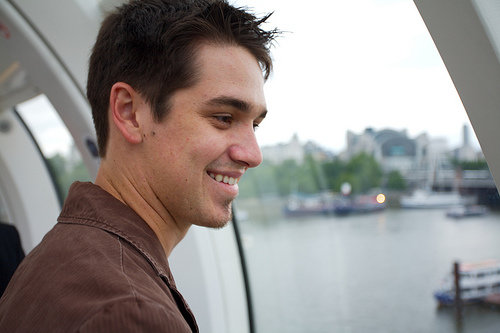
At the time of the tour I felt somewhat hesitant at how we would be welcomed, at how residents would perceive two giant buses of college students coming to visit the place where they live, a place that is experiencing environmental injustice. Then I realized that it is important to be able to look at Hunters Point with a helping eye. I think that the residents are starting to realize that they cannot keep living in ignorance if they are, and that whatever can be done to help, whether it be through education or through government intervention, must be done.

I must say, it was wet and freezing outside. We were given the opportunity to vote on whether or not we would like to be given the tour on the bus, or step outside and somewhat experience the surroundings. At the time I did not want to be cold, but reflecting on the experience, I am glad we stepped outside and Saul talked to us. I believe the whole field trip was an interesting progression that can be related to what should be done at Hunters Point.

First, Saul Bloom came to speak to us in Cowell hall, and gave us a lecture about what has happened at Bayview and what is being done to reverse negative effects. Then we got on the bus to go down there, and then we got off the bus and really were kind of intensive. I think if that same process was translated to the residents and all involved with Hunters Point; education, grouping together, and forcing action, then some sort of environmental justice and progress would be had.
The median income in San Francisco is around $11,000 more than that of Bayview/Hunters Point. The average income is about $12,000 more. Fifty-four percent of San Francisco residents as a whole are white, eleven percent is black, and twenty-nine percent are Asian/Pacific islander. In Bayview/Hunters Point, eleven percent is white, sixty-four percent are black, and twenty percent are Asian/Pacific islander. Forty-six percent of Bayview/Hunters Point household incomes are less than $25,000 a year. Census Data
The soil, groundwater and air contain chemicals and materials that are considered hazardous to human health and/or the environment. Polychlorinated biphenyls (PCBs), pesticides, petroleum hydrocarbons, solvents, and radiological debris are just some of contaminants that
 have been found at the Shipyard, and some of the old buildings are known to have lead and asbestos.
have been found at the Shipyard, and some of the old buildings are known to have lead and asbestos.Polychlorinated biphenyls or PCB’s, are persistent contaminants that impact the brain, nervous and hormone systems. PCBs were banned in the 1970s but despite the ban, human exposure continues from fatty foods. PCB’s effect the brain and nervous system, endocrine system, may cause cancer, problems with reproduction and fertility, birth or developmental effects, or negative effects to the immune system (including sensitization and allergies).
Clean drinking water is a simple necessity that everyone no matter what race or economic status should be able to have. Disproportionate exposure to
 pollutants in the air is horrible due to everyone in the community’s right to breath clean air, and pollutants in the buildings will scrape off, into the air and water, also allowing no one the opportunity to use the buildings.
pollutants in the air is horrible due to everyone in the community’s right to breath clean air, and pollutants in the buildings will scrape off, into the air and water, also allowing no one the opportunity to use the buildings.The soil and groundwater at the Shipyard as well as some of the area neighboring HPS
are contaminated by materials such as PCBs, pesticides, petroleum hydrocarbons, solvents, and
radiological debris at levels disproportionately higher than what is allowed by the state or federal government. If the contaminated soil and water gets into the drinking supply, residents are exposed to possible birth defects, health risks and disease.
According to the Community window on the shipyard it should take 7-10 years after October 2004. The Alice Griffith public housing project south of the slough is scheduled for improvement and should be incorporated in an overall program to stimulate new housing
 growth. The Alice Griffith site includes a large tract of vacant land, over 300,000 square feet, owned by the Housing Authority and zoned for moderate density residential. There is also a more noticeable need for certain larger retail functions, including a grocery store and a clothiers that may be established.
growth. The Alice Griffith site includes a large tract of vacant land, over 300,000 square feet, owned by the Housing Authority and zoned for moderate density residential. There is also a more noticeable need for certain larger retail functions, including a grocery store and a clothiers that may be established.The Bayview community is experiencing environmental injustice. The statistics complete the definition of what environmental justice is. That 46% of Bayview/Hunters Point household incomes are less than $25,000 a year, and that the demographic is primarily non-white; as well as chemicals and materials that are considered hazardous to human health and/or the environment being at levels disproportionately higher than what is allowed by the state or federal government.
San Francisco Planning Department Area Plan: Bayview Hunters Point
Community Window on the Shipyard Fact Sheet
Pollution, Health, Environmental Racism and Injustice:
Scorecard.org Pollution report card
Straight Outta Hunters Point Documentary Part One
Straight Outta Hunters Point Documentary Part Two




